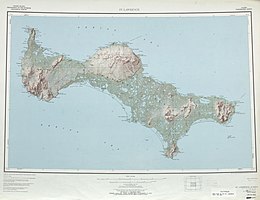 Closeup map of St. Lawrence Island | |
| Geography | |
|---|---|
| Location | Bering Sea |
| Coordinates | 63°21′44″N 170°16′02″W / 63.36222°N 170.26722°W |
| Area | 1,791.56 sq mi (4,640.1 km2) |
| Length | 90 mi (140 km) |
| Width | 22 mi (35 km) |
| Highest point | Atuk Mountain, 2,070 ft (630 m) |
| Administration | |
United States | |
| State | Alaska |
| Census Area | Nome Census Area |
| Largest settlement | Savoonga (pop. 835, 2020) |
| Demographics | |
| Population | 1,475 (2020) |
| Pop. density | 0.32/km2 (0.83/sq mi) |
| Ethnic groups | Siberian Yupik |
St. Lawrence Island (Central Siberian Yupik: Sivuqaq, Russian: Остров Святого Лаврентия, romanized: Ostrov Svyatogo Lavrentiya) is located west of mainland Alaska in the Bering Sea, just south of the Bering Strait. The village of Gambell, located on the northwest cape of the island, is 50 nautical miles (95 kilometers) from the Chukchi Peninsula in the Russian Far East. The island is part of Alaska, but closer to Russia and Asia than to the Alaskan and North American mainland. St. Lawrence Island is thought to be one of the last exposed portions of the land bridge that once joined Asia with North America during the Pleistocene period.[1] It is the sixth largest island in the United States and the 113th largest island in the world. It is considered part of the Bering Sea Volcanic Province.[2] The Saint Lawrence Island shrew (Sorex jacksoni) is a species of shrew endemic to St. Lawrence Island.[3] The island is jointly owned by the predominantly Siberian Yupik villages of Gambell and Savoonga, the two main settlements on the island.[4][5]
- ^ "Tools and Implements: St. Lawrence Island and the Bering Strait Region". University of Missouri-Columbia Museum of Anthropology. Retrieved 2006-05-24.
- ^ The 40Ar/39Ar chronology and eruption rates of Cenozoic volcanism in the eastern Bering Sea Volcanic Province, Alaska
- ^ "Wildlife Notebook Series: Shrews". Alaska Department of Fish and Game.
- ^ "St. Lawrence Island corporations get clear title to their land". The Nome Nugget. 2016-08-05. Retrieved 2023-01-09.
- ^ KTUU, Travis Khachatoorian /. "Million-acre St. Lawrence Island land title signed over to native population". www.alaskasnewssource.com. Retrieved 2023-01-09.
